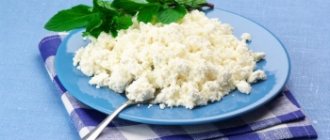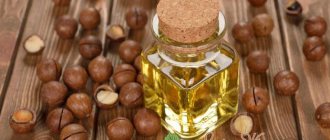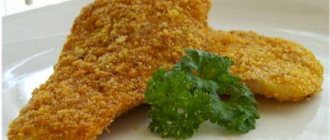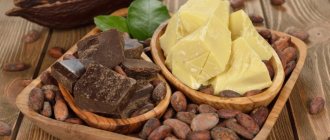Properties of orange
Nutritional value and composition | Vitamins | Minerals
How much does an orange cost (average price for 1 kg)?
Moscow and Moscow region.
60 rub.
Orange is the fruit of the orange tree. Most of us are familiar with the appearance and taste of this “sunny” fruit. Perhaps it is the most famous and popular member of the citrus family. The word "orange" is of Dutch origin and means "Chinese apple", thus clearly hinting at the country of origin of the orange.
For a long time, orange was a delicacy that only royal families could afford. Now orange is widespread; the leaders in the export of this fruit are Spain, the USA, South Africa and Morocco.
There are many uses for oranges. They are, of course, consumed fresh and used in the preparation of candied fruits, jams, and marmalades. Orange juice is one of the healthiest and most popular fruit juices; it perfectly quenches thirst. Orange zest contains orange essential oil, which is widely used in the production of fruit and alcoholic beverages, as well as in dairy production.
Unusual uses of orange peel
The pulp of the fruit in question can simply be eaten, or juice can be made from it. How to properly use the peel of this fruit? The dried peel is great for lighting a fireplace - it contains a lot of essential oils that will instantly start a fire and fill the room with a pleasant aroma. And if indoor flowers are constantly under attack by a cat, then simply place dried orange peel on the windowsill - the purring animals will completely forget about their fun.
You can make jam and preserves from orange peels, make aromatic liqueur or liqueur. Or you can simply put the dried peel of the fruit in question into canvas bags and hang it around the room - and the aroma will be very pleasant, and flies/mosquitoes will fly around the house.
Oranges not only have excellent taste, but can also benefit the body. It is important not to overuse this fruit - you need to exclude contraindications and observe moderation, since too much citrus fruit can cause a severe allergic reaction.
7, total, today
( 170 votes, average: 4.48 out of 5)
Cod liver: benefits and harms
The benefits and harms of flaxseed oil
Related Posts
Benefits of orange
The beneficial properties of orange became known back in the 17th century. And now everyone, young and old, knows about them. It’s no secret that citrus fruits are real record holders for vitamin C content. In an orange, this figure reaches 65 mg. per 100 gr. product. In addition to vitamin C, oranges are rich in vitamins A, B and P, essential for humans. The phytoncides present in the fruit are natural antibiotics and indicate the benefits of orange in the fight against many diseases.
Regular consumption of oranges has a beneficial effect on the gastrointestinal tract. Oranges are recommended for vitamin deficiencies, not only for treatment, but also for prevention. Orange juice is good for liver and lung diseases; it also helps with anemia and joint problems. Potassium and vitamin C, generously contained in oranges, help with atherosclerosis, hypertension, and obesity.
The benefits of orange have been confirmed by nutritionists. Orange is a real find for those who are fighting for a beautiful figure. The calorie content of an orange is 36 kcal. per 100 grams, and the rich nutrient content helps support the body in a stressful situation associated with weight loss. There are even orange diets, widely known in the world of nutrition.
Oranges have a tonic effect, relieve fatigue and reduce sensitivity to cold. The benefits of orange are also obvious in cosmetology, where it is used in various forms to combat dry skin. In addition, masks with orange perfectly saturate the skin with vitamins.
Nutritional value of orange, its chemical composition
Nutritional value 100 g:
- Calorie content: 43 kcal
- Proteins: 0.9 g
- Fat: 0.2 g
- Carbohydrates: 8.1 g
Show full list »
- Dietary fiber: 2.2 g
- Organic acids: 1.3 g
- Water: 86.8 g
- Mono- and disaccharides: 8.1 g
- Ash: 0.5 g
Vitamins:
- Vitamin PP: 0.2 mg
- Beta-carotene: 0.05 mg
- Vitamin A (VE): 8 mcg
- Vitamin B1 (thiamine): 0.04 mg
- Vitamin B2 (riboflavin): 0.03 mg
- Vitamin B5 (pantothenic): 0.3 mg
- Vitamin B6 (pyridoxine): 0.06 mg
- Vitamin B9 (folate): 5 mcg
- Vitamin C: 60 mg
- Vitamin E (TE): 0.2 mg
- Vitamin H (biotin): 1 mcg
- Vitamin PP (Niacin equivalent): 0.3 mg
Macronutrients:
- Calcium: 34 mg
- Magnesium: 13 mg
- Sodium: 13 mg
- Potassium: 197 mg
- Phosphorus: 23 mg
- Chlorine: 3 mg
- Sulfur: 9 mg
Microelements:
- Iron: 0.3 mg
- Zinc: 0.2 mg
- Iodine: 2 mcg
- Copper: 67 mcg
- Manganese: 0.03 mg
- Fluoride: 17 mcg
- Boron: 180 mcg
- Cobalt: 1 mcg
The calorie content of an orange is very low - only 43 Kcal per 100 g of product, but its content of vitamins and minerals is quite high.
Naturally, when you mention an orange, you immediately remember that it contains a lot of vitamin C - by eating just 150 g of this fruit, a person will cover his body’s need for this vitamin for a day. The product in question, in addition to vitamin C, contains iron and magnesium, calcium and sodium, fluorine and copper.
The orange pulp contains fintocides, but the peel is rich in essential oils - these components of the fruit will help maintain the functioning of organs and systems at the proper level.
Harm of orange
The high content of acids and sugar makes oranges harmful for peptic ulcers, gastritis, and diabetes. For the same reason, oranges do not have a very good effect on the condition of tooth enamel, thinning it, resulting in increased tooth sensitivity. It is worth recalling allergic reactions to citrus fruits, which are extremely common in the modern world. This is where the contraindications to consuming these fruits end; the issue of the relationship between harm and benefit of oranges is always decided individually.
Description and features of orange
Orange is a fruit, but according to biological parameters, it is a berry consisting of segments . Each lobe is covered with a thin shell . The skin of this fruit consists of two layers:
- Quite soft, spongy shell of white color;
- Upper thin skin.
The last layer has a distinctive smell and a variety of colors, depending on the type of fruit. This fruit almost always has a round shape. Weight and size also vary among varieties. The taste of the fruit can be sweet and sour and sweet, with the former being in high demand.
China is considered the birthplace of these fruits, but according to some sources, it is obvious that the regions of the Mediterranean and South America also knew about the existence of oranges since ancient times. Currently, the following countries are considered the main suppliers of oranges:
- Türkiye;
- Spain;
- China;
- Greece;
- Egypt;
- Sicily;
- Pakistan;
- South Africa;
- Southern states of America;
- India.
Calorie content of fruits
The calorie content of fruits is due to the high content of carbohydrates, tannins, organic acids, essential oils, vitamins and minerals. Of the carbohydrates, they most often contain fructose, glucose and sucrose - safe sugar substitutes.
The calorie content of fruits can vary quite widely. It can differ not only in different fruits, but also among different varieties and individual fruits of the same species. The most high-calorie bananas are bananas, 100 g of which contain 90 calories. They are followed by grapes (70 kcal), mango (67 kcal), persimmon (62 kcal). The most “harmless” for the figure are apples (45 kcal), apricots (41 kcal), oranges (37 kcal), grapefruits (35 kcal). Well, the leader in calorie content is avocado (183 kcal). However, few people consider it a fruit, and they certainly don’t want to feast on it in large quantities. Although…
Calorie content of 1 orange. Oranges for weight loss
The calorie content of 1 orange does not exceed 100 kcal. Oranges are an ideal product for weight loss due to their availability, nutritional value and low calorie count. Orange promotes a long-lasting feeling of fullness, which is an important component in the fight against extra pounds, due to the high fiber content in its pulp.
The calorie content of red oranges is at the same level, while it is red varieties of oranges that are most preferable for weight loss, since they most effectively prevent fat deposition.
In order to diversify your diet menu, you should include fresh oranges in various salads and other dishes.
The beauty of the orange diet is that it requires you to limit your diet for five days of the week, and on the weekend you can eat as usual. This regimen is followed for three weeks, with the expected weight loss being about ten kilograms.
The orange diet does not regulate breakfasts, lunches and dinners, but offers a specific list of foods that are recommended to be eaten during the day. So, during the first week, consume one kilogram of orange and two hard-boiled eggs daily; drink at least 2 liters of still water. In the second week, eggs are replaced with porridge (preferably buckwheat and cooked without salt), and in the third - with fresh and boiled vegetables.
Orange weight loss is effective, healthy and tasty. It is quite easily tolerated despite the fact that there are few calories in an orange, and is available at any time of the year. A contraindication for consuming any oranges is the presence of an allergic reaction or individual intolerance.
www.neboleem.net
Application in cosmetology
Orange oil is an excellent remedy for strengthening and rejuvenating skin and hair. It is widely used in the manufacture of many cosmetics. Creams based on essential oils help fight the first age-related changes in the skin.
At home, to give your hair a healthy shine, you can drop a little oil into a hair spray and then spray. A fragrant and useful remedy for removing rough skin is orange essential oil. To get rid of corns and restore softness to the skin of your feet, you need to soak cotton socks in oil, then put them on your feet, wrap them with film, and put on another warm socks on top. 1 hour after application, the product should be washed off.
It is worth remembering that essential oil cannot be used in its pure form, as it can cause burns. In combination with it, you can use Vaseline, baby cream or any other neutral cosmetic product, as well as vegetable oils, sour cream and cream as a base.
Calorie table
To speed up and more effectively lose weight, it is advisable to calculate the amount of calories consumed. The following table will help determine the calorie content of individual fruit products per 100 grams:
| Fruits | Calories | Squirrels | Carbohydrates | Fats |
| Apricot | 45 | 1 | None | 10 |
| Cranberry | 25 | 0,2 | None | 5 |
| A pineapple | 51 | 0,5 | None | 12 |
| Avocado | 200 | 1,7 | 20 | 6 |
| Banana | 95 | 1 | 0,3 | 22 |
| Black currant | 60 | 1 | None | 14 |
| Cherries | 77 | 1 | None | 17 |
| Chestnut | 211 | 14 | 3 | 42 |
| Lemon | 40 | 1 | None | 9 |
| Clementine | 40 | 0,8 | None | 9 |
| Coconut | 371 | 4 | 35 | 10 |
| Figs | 80 | 1 | None | 19 |
| Strawberry | 36 | 1 | None | 7 |
| Raspberries | 40 | 1 | None | 8 |
| passion fruit | 100 | 3 | None | 22 |
| Guava | 60 | 0,7 | None | 25 |
| Pomegranate | 64 | None | None | 16 |
| Currant | 30 | 1 | None | 6 |
| Persimmon | 63 | 0,5 | None | 15 |
| Kiwi | 53 | 1,6 | 0,3 | 11 |
| Lychee | 68 | 0,7 | None | 16 |
| Mandarin | 40 | 1 | None | 9 |
| Mango | 62 | 0,4 | None | 15 |
| Melon | 31 | 0,5 | None | 6,5 |
| Blackberry | 57 | 1 | None | 12 |
| Blueberry | 16 | 0,5 | None | 2,5 |
| Orange | 40 | 1 | None | 8,9 |
| Papaya | 44 | 0,6 | None | 10 |
| Watermelon | 30 | 0,4 | None | 7 |
| Peach | 47 | 0,5 | None | 11 |
| Pear | 61 | 0,4 | None | 14 |
| Apple | 52 | 0,3 | None | 12 |
| Grape | 83 | 1 | 1 | 17 |
| Grapefruit | 40 | 1 | None | 9 |
| Fruits (compote) | 100 | None | None | 25 |
| Avocado (1 pc.) | 425 | 3,6 | 42 | 13 |
Calorie content of orange per 100 grams. Energy value: how to calculate?
There are many varieties of orange, and therefore their calorie content may vary. This is also affected by the size of the fruit and its ripeness. But don’t be fooled: despite the fact that the fruit is low in calories, it contains a large amount of fructose, which can cause weight gain.
Considering that the approximate calorie content of an orange is 36 kcal per 100 grams, the energy value of a whole medium-sized ripe fruit is 80 kcal.
The calorie content of freshly squeezed juice will have a slightly different value. It is calculated taking into account the pulp of the fruit; its approximate value per 100 milliliters is approximately 45 kcal.









